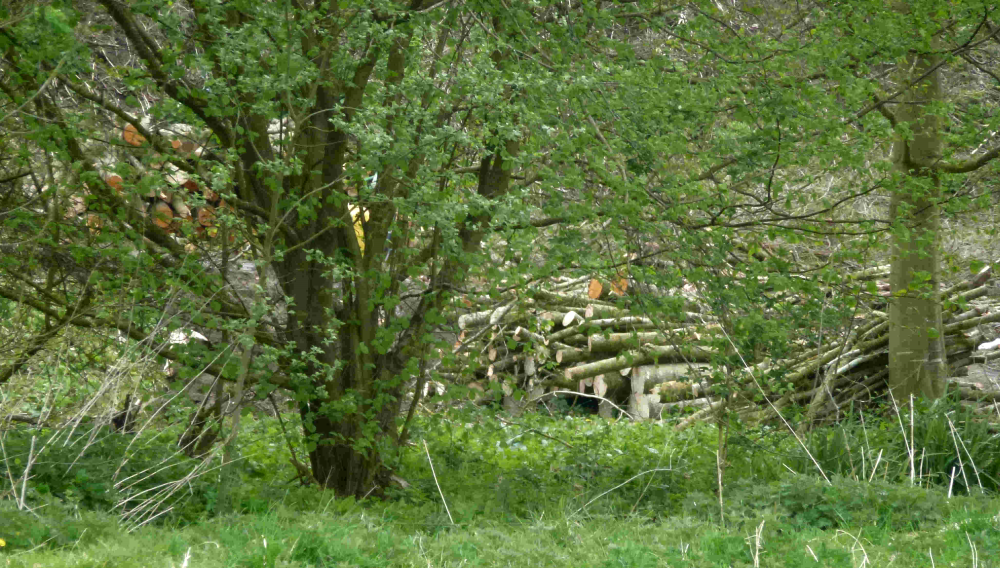The numbers are shocking and I am sure they will be challenged by the developer. A calculation by Shropshire Council’s tree team suggests that around 644 trees will have been lost during the lengthy seven year saga to develop the site at the rear of Linney House on the banks of the Corve, if the current development of eight homes is given the green light to go ahead. This is a high end estimate. It more likely that only a third of that number will be lost without replanting.
The council’s tree team notes that only an indicative landscape plan for planting replacement trees has been submitted with the latest application. It now up to the developer to flesh out the details of compensatory planting. Even then, I doubt that the full number of trees can be replaced. Not for the first time recently, this raises the question about how developers can be obliged to compensate for loss of biodiversity.
The site has a complex planning history dating back to 2012. It has received planning permission twice and a third application is now being considered by planning officers. This application is a much better design than its predecessors.
Many people do not want this site developed at all and I would be of that opinion if I thought that the council could reject a new planning application within national planning rules. But the reality that the site already has planning permission. There are no objections from Shropshire Highways or the Environment Agency to the new plans. That means that a planning inspector would almost certainly overturn any refusal of permission by Shropshire Council, possibly awarding costs against the council.
But there is still a lot to get sorted out before this proposal, submitted six months ago, can be approved. Notwithstanding the green character of the scheme, the major issue is the number of trees that have been lost, will be lost and will not be replanted.
In 2015, the site owner felled 157 trees without given Shropshire Council the required six weeks’ notice under the Town and Country Planning Act 1990 for felling trees in conservation areas, known as a Section 211 Notice. (Wyre Council gives a good summary of how this obligation operates). A further 99 trees were removed legally under the first approved planning application (12/02275/FUL, renewed as 17/00230/FUL). Shropshire Council’s tree team has mapped out the tree loss.
The developer agreed to plant 100 whips in compensation for the Section 211 breach and plant another 183. However, there is no commitment to keeping the 100 whips or planting the 182 in the current planning application (19/00826/FUL). The maintenance of the 100 whips “has been poor with no effort to keep weeds down or to replace losses” according to the tree team.
Another 105 mature trees will be lost under the new application. This gives a total loss of 644 trees according to the tree team, leading it to conclude that it cannot support the application.
But that headline number somewhat overstates the situation at Linney House. Prior to 2015, there were 401 trees on site. At present, just 49 mature trees will be retained. But the developer has made it clear that there will be compensatory planting. The problem is that no details have been provided
I don’t think this development can be approved until we see a lot of detail about compensatory planting for trees lost.
This application is being considered at a time when both Shropshire Council and Ludlow Town Council have declared a climate emergency. The government has committed to mandating that all developers should lead to a 10% net gain in biodiversity, but the Environment Bill may not survive the current febrile political environment.
I would like developers to be ambitious about increasing biodiversity. I would like communities to be the same. A community woodland the other side of Corve would be a bonus to both Ludlow and the environment.






Surely it’s academic how many trees will have been lost on this site: the felling in 2015 was also illegal because it was carried out during the middle of the nesting season, evenings and at weekends. The fact remains the site is in a conservation area and should be treated as sensitive since it forms a wildlife corridor to the Teme SSSI. The architect’s painting is misleading in the suggested amount of tree cover, since the pressure of 8 lots of residents on the site is unlikely to allow trees to develop to maturity.
Shropshire Highways comments are not supportive of the scheme – their report requests a lot more detail first from the developer.